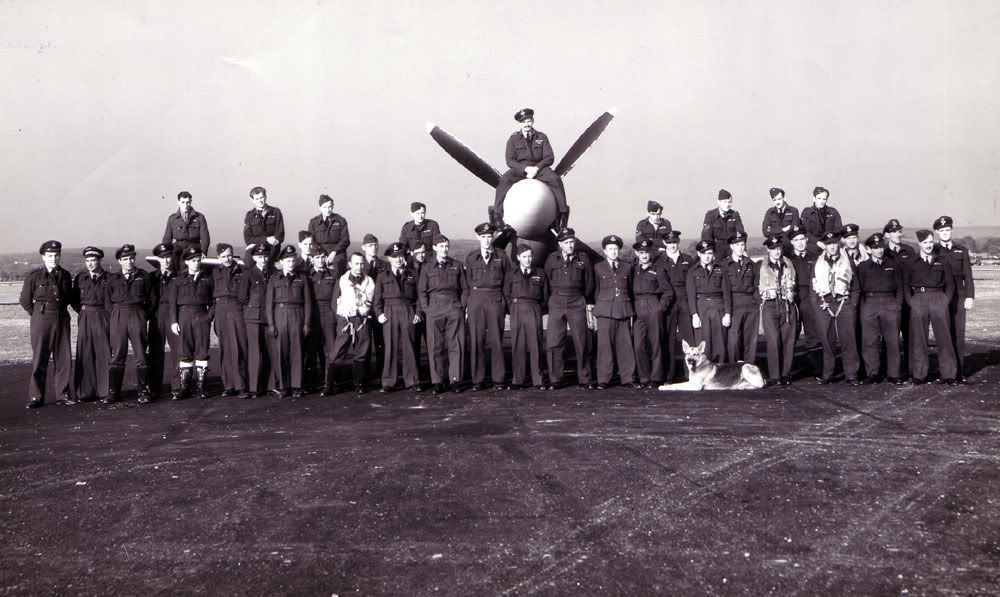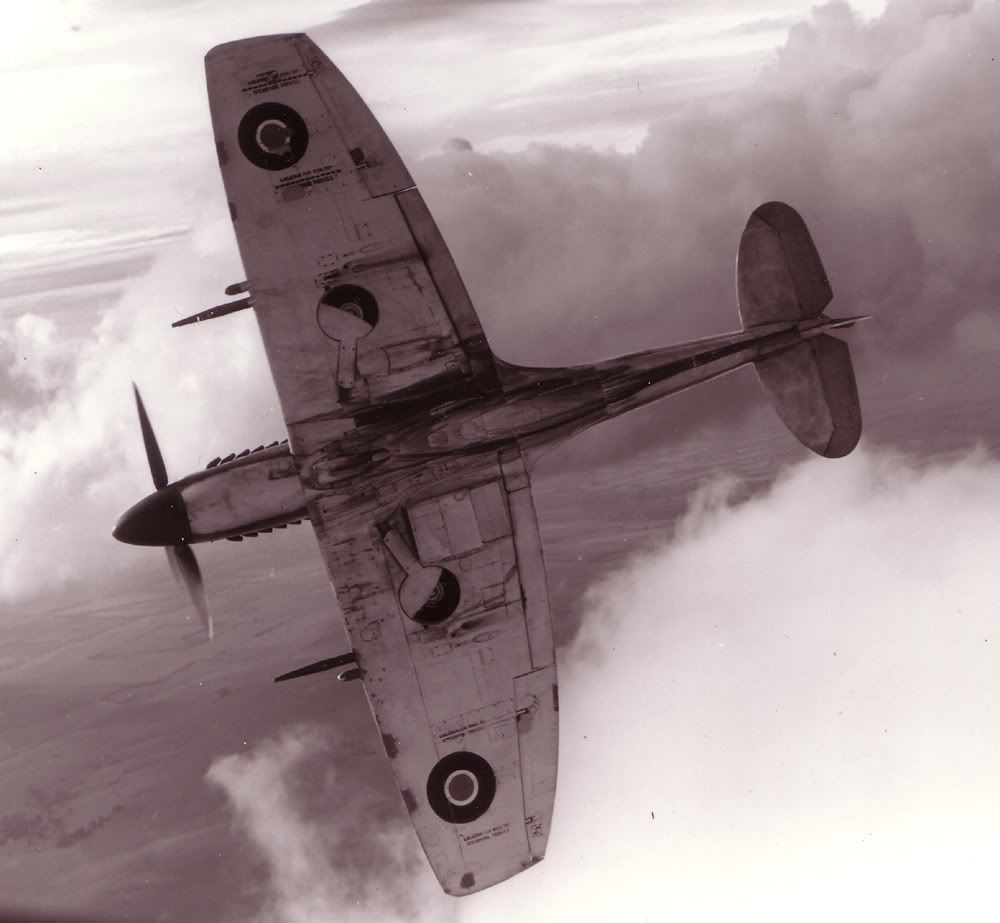Forums
- Forums
- Duggy's Reference Hangar
- RAF Library
- Supermarine Spitfire Mk IV DP845 (Later Mk XX, and Mk XII)
Supermarine Spitfire Mk IV DP845 (Later Mk XX, and Mk XII)
Post a reply
- Go to Previous topic
- Go to Next topic
- Go to Welcome
- Go to Introduce Yourself
- Go to General Discussion
- Go to Screenshots, Images and Videos
- Go to Off topic
- Go to Works in Progress
- Go to Skinning Tips / Tutorials
- Go to Skin Requests
- Go to IJAAF Library
- Go to Luftwaffe Library
- Go to RAF Library
- Go to USAAF / USN Library
- Go to Misc Library
- Go to The Ops Room
- Go to Made in Germany
- Go to Campaigns and Missions
- Go to Works in Progress
- Go to Juri's Air-Raid Shelter
- Go to Campaigns and Missions
- Go to Works in Progress
- Go to Skinpacks
- Go to External Projects Discussion
- Go to Books & Resources
-
13 years agoWed Apr 06 2016, 12:18pm
 Main AdminWhile there was some interest in replacing the Rolls-Royce Merlin in the Supermarine Spitfire with a bigger engine as early as 1938, it wasn?t until 1941 that the Air Ministry pursued the idea with enthusiasm issuing Specification F.4/41 tailored to the new version, although a verbal instruction to start the design process had been issued by Sir Wilfred Freeman, the Air Council member for Research and Development, early in 1940. The engine that Supermarine and Rolls-Royce proposed was the Griffon, which originated as a ?de-rated? ?R? engine the power unit of the Schneider Trophy winning S.6B floatplane. The new engine was a third bigger than the Merlin ? 37 litres compared with 27 - but was physically small enough to fit the basic Spitfire airframe with only small modifications.
Main AdminWhile there was some interest in replacing the Rolls-Royce Merlin in the Supermarine Spitfire with a bigger engine as early as 1938, it wasn?t until 1941 that the Air Ministry pursued the idea with enthusiasm issuing Specification F.4/41 tailored to the new version, although a verbal instruction to start the design process had been issued by Sir Wilfred Freeman, the Air Council member for Research and Development, early in 1940. The engine that Supermarine and Rolls-Royce proposed was the Griffon, which originated as a ?de-rated? ?R? engine the power unit of the Schneider Trophy winning S.6B floatplane. The new engine was a third bigger than the Merlin ? 37 litres compared with 27 - but was physically small enough to fit the basic Spitfire airframe with only small modifications.
The first of two prototypes known initially as the Spitfire Mk IV, DP845 first flew on 27 November 1941 in the hands of Jeffrey Quill, the Supermarine test pilot who was to carry out much of the development work on the type. While based on the Spitfire Mk I, it had the bulged fairings along the nose above the exhausts that were to become a characteristic of Griffon Spitfires, to minimise the effect of the bigger engine on the pilot?s forward view. During its career its retractable tailwheel was replaced with the more usual fixed type, and it was fitted with a larger rudder and eventually a redesigned tail unit to counter the greater torque from the Griffon; for a while it carried a mock-up installation for six 20 mm. cannon, but it reverted to the more usual two cannon and four machine guns.
It spent all its life carrying out development tasks in the hands of manufacturers Supermarine and with the Aeroplane and Armament Experimental Establishment at Boscombe Down, flying at some time with the ?clipped? wings that were a feature of the resultant production Spitfire Mk XII; the type was renumbered to avoid confusion with the PR Mk IV, and was known for a while as the Mk.XX. In one of its trials it reached 450 mph. in a dive. It survived until 1946, when it was in the hands of No.1 MPRD at Cowley.
DP845?s day in the spotlight was 20 July 1942 at Farnborough, where a competitive trial with a Hawker Typhoon and a captured Focke-Wulf Fw 190 (for which its captors had considerable regard) was organised, and in the hands of Jeffery Quill the Spitfire outperformed them both in the required race, somewhat to the surprise of the sponsors!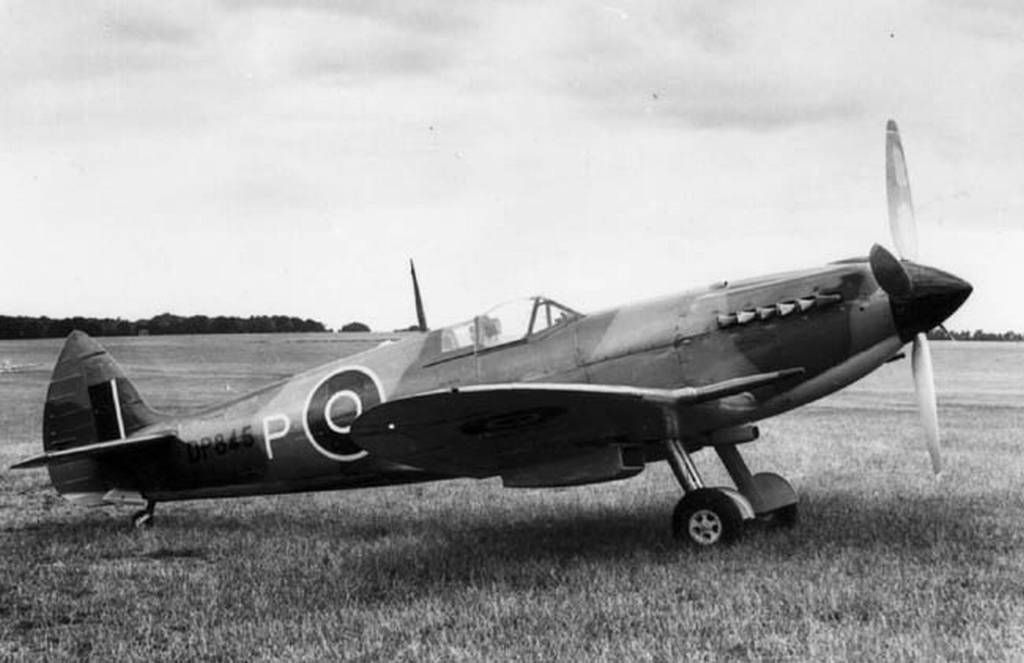
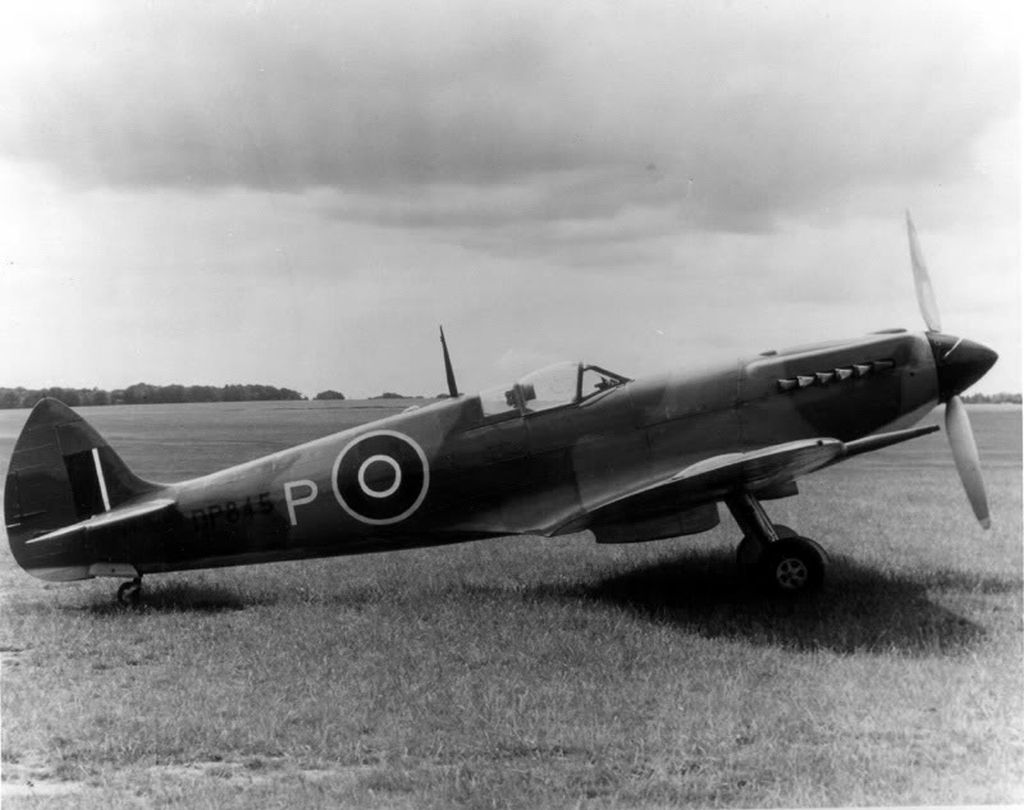
Below with 6x20mm install.
Below with clipped wings.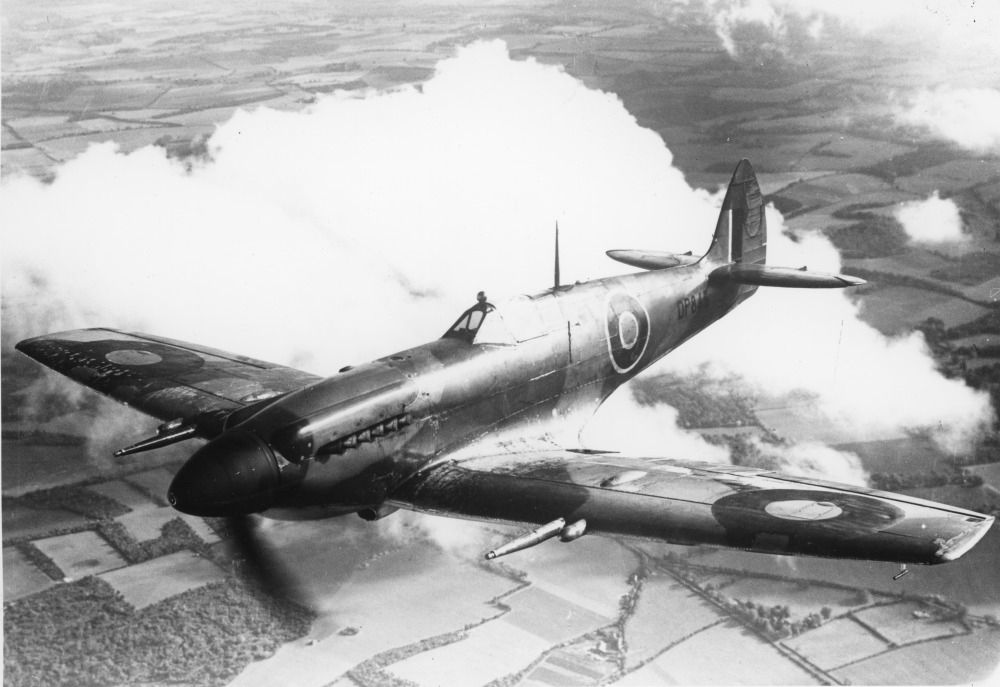
Regards Duggy -
9 years agoFri Nov 26 2021, 02:18pmDuggy
 Main AdminThe Spitfire Mk XII was essentially a standard Spitfire VC airframe modified to take a Griffon III engine. A four-blade Rotol propeller, rotating clockwise - the reverse of the Merlin, was fitted to the Griffon engine. The aircraft was designed to be a high performance low altitude fighter and was delivered with clipped wings to improve manoeuvrability. Compared to the Spitfire V, the bulge over the cannon feed on the mainplane was much smaller, the rudder and trimming tabs were larger, and the engine cowlings and spinner differed considerably in order to accommodate the Griffon engine. The universal wing of the Spitfire V was fitted, armament being two 20 mm cannon and four .303 machine guns. While early models were based on the Spitfire V airframe, subsequent aircraft utilized the Spitfire VIII fuselage which incorporated such refinements as flush rivetting and a retractable tail wheel. All models were fitted with the broad chord rudder of the Spitfire VIII. The fuel capacity was 85 gallons with provision made for jettison tanks. The operational weight with full fuel and ammunition was 7,400 lbs. While the Griffon III engine was fitted to the majority of Spitfire XIIs, the Griffon IV engine was fitted to the last 15 aircraft built which were delivered in July and August 1943. A total of 100 Mk XIIs were built.
Main AdminThe Spitfire Mk XII was essentially a standard Spitfire VC airframe modified to take a Griffon III engine. A four-blade Rotol propeller, rotating clockwise - the reverse of the Merlin, was fitted to the Griffon engine. The aircraft was designed to be a high performance low altitude fighter and was delivered with clipped wings to improve manoeuvrability. Compared to the Spitfire V, the bulge over the cannon feed on the mainplane was much smaller, the rudder and trimming tabs were larger, and the engine cowlings and spinner differed considerably in order to accommodate the Griffon engine. The universal wing of the Spitfire V was fitted, armament being two 20 mm cannon and four .303 machine guns. While early models were based on the Spitfire V airframe, subsequent aircraft utilized the Spitfire VIII fuselage which incorporated such refinements as flush rivetting and a retractable tail wheel. All models were fitted with the broad chord rudder of the Spitfire VIII. The fuel capacity was 85 gallons with provision made for jettison tanks. The operational weight with full fuel and ammunition was 7,400 lbs. While the Griffon III engine was fitted to the majority of Spitfire XIIs, the Griffon IV engine was fitted to the last 15 aircraft built which were delivered in July and August 1943. A total of 100 Mk XIIs were built.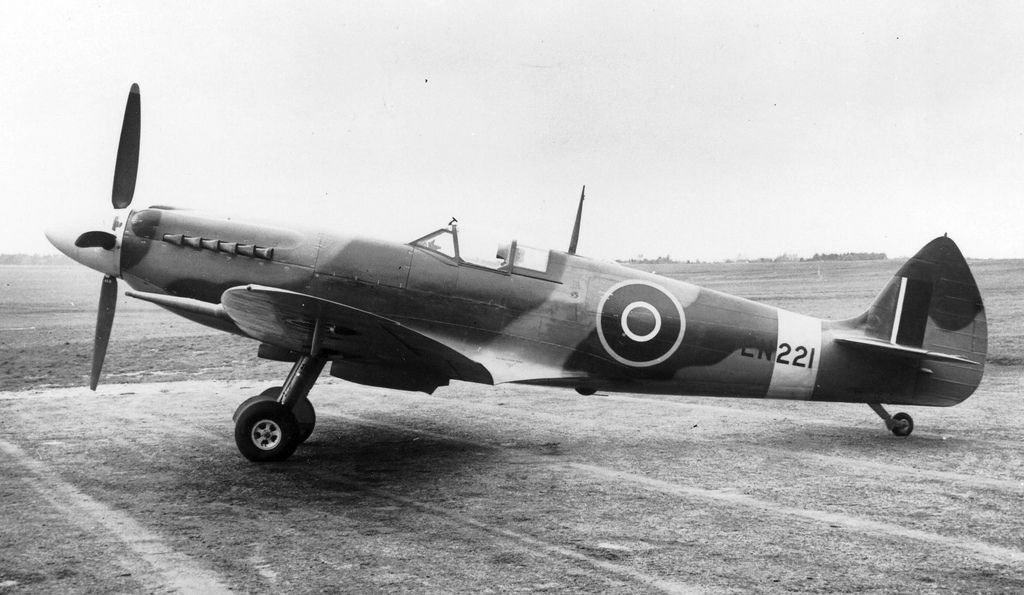
The first production aircraft (EN.221) was delivered in October 1942. No. 41 Squadron began re-equipping with Spitfire XII?s when they moved to High Ercall at the end of February, 1943. March was spent working up on the new aircraft. The Squadron Operations Record Book (ORB) noted for 30 March ?Two more Spitfire XII aircraft arrived during the afternoon, and thus brought the Squadron up to full establishment with these aircraft.? The first operational sorties with the Spitfire XII?s occurred on 3 April, Form 541 noting ?Scramble base at Valley to 27,000 ft. Nothing to report?. Intensive operations, however, began after the squadron moved to Hawkinge on 13 April. 41 Squadron took over the duties of 91 Squadron, which went off operations and moved to Honiley to also re-equip with Spitfire XII?s. F/O R. H. W. Hogarth drew first blood, shooting a Ju 88 down into the sea 2 miles North of Ostend on 17 April. On 27 April Blue Section engaged 4 FW 190?s while carrying out a recco to Calais-Somme. F/O C. R. Birbeck downed one of the FW.190?s, thus marking the Spitfire XII?s first confirmed victory against a German fighter. Operational duties for April included recco?s of French ports such as Dieppe, Ostende and Calais; recco?s of shipping along the French coast and in the English Channel; patrols of Dungeness and Hastings area; and scrambles.
91 Squadron went operational with their Spitfire XII's when they moved back to Hawkinge in May. 41 Squadron moved to Biggin Hill on 21 May, followed by a move to Friston on the 28th. Their primary duty, as recorded in their ORB, was now to ?protect the coastal towns against tip and run raiders?. 91 Squadron downed five of these tip and run 190?s on 25 May, the Squadron Diary noting:
We got the Huns tonight - five of them, all in the drink. It was a grand occasion for 91 Squadron, and this entry ought to be typed in red. We had been flying all day, but the weather closed in towards evening with heavy clouds - in fact F/O Hoornaert and F/Sgt. McPhie had to land at Lympne because of heavy rain when returning from patrol at 19.30 hours. However, the C.O., with Johnny Round as his No. 2 and F/O Maridor and P/O Davy Nos. 3 and 4, went on a low patrol of Dungeness area at 21.25 hrs. They were not out long and came in to land at 21.50 hrs. This was when the fun started, for about 12 F.W. 190's came in with the intention of dealing a shrewd blow at Folkestone at about this time. The C.O. and Johnny had landed and just taxied to dispersal when the greens were fired, so whipped off again smartly, while Maridor and Davy, who were circling to land, went "Through the gate" to Folkestone. There were gutteral cries of 'Alarm' 'Alarm' from the surprised Huns, who broke away and ran for home, dropping their bombs in the sea, except for one, which fell in a bathing pool and injured one person. The XII's had the legs of the 190's, and having flown through a lively A.A. barrage, smacked down five of them, two falling to the C.O., one to each of the others. Matt and Kyn, who had been scrambled, saw some of this, but didn't get a chance to have a crack at anything themselves, while F/O Bond, who made a smart get-away on a second scramble a minute or so later, saw a 190 go straight in near Gris Nez. It turned out that this must have been the one that Davy had engaged, which was disappointing for Bond, who thought he had scared the bandit in the drink himself. After this, the C.O. was in the chair and behind the bar, and rather more of the odd beers were drunk rather later than usual .....
41 Squadron departed from the usual scrambles and coastal patrols on the 27th in order to perform an ?Offensive rhubarb on Ault, Beauchamp and Tocqueville?. 41 Squadron got a crack at the tip and run raiders on 4 June when 18 FW 190's raided Eastbourne. F/O J. Solak (Polish) intercepted them at sea level and shot one down into the water, while F/O D. H. Smith roughed up another but didn't see it go in. It was 91 Squadron?s turn again two days later when P/O D. H. Davy and Sgt. J. T. Watterson ran down a FW 190 heading south from Beachy and shot it down into the sea.
41 Squadron moved to Westhampnett, a satellite field of Tangmere, on 21 June. Marking a shift in operational duty, on 26 June the squadron provided withdrawal support for 60 Fortesses which were bombing Le Mans. Two days later, on the 28th, 91 Squadron joined 41 at Westhampnett to form the Tangmere Spitfire XII Wing. Led by Wing Cdr. Rhys Thomas, the newly formed Spitfire XII Wing carried out its first joint mission on 29 June, a Ramrod escorting Fortresses to Le Mans. During July the Tangmere Wing (Spitfire XII) was primarily engaged in Ramrods - escorting Fortresses, Mitchells, Marauders, as well as Typhoons to attack targets in France. These targets included the marshalling yards at Amiens and St. Omer; airdromes at Poix, Abbeville and Tricqueville; and assorted targets at Le Havre, Villacoubay, Le Bourget and Yainville. The Wing would often sweep ahead of the main bomber formation. Other times they would provide target support, withdrawal support or escort cover. Rhubarbs were carried out when the weather was not conducive to bombing, the favorite target being trains. The Tangmere Wing received the following Signal dated 15/7 from General Anderson Commanding 8th U.S. Bomber Command:
American Bomber Crews are enthusiastically grateful for the splendid fighter cover provided today by the Spitfire Pilots of your Command. Following are typical comments of our crews ?As we were leaving the Target area a heavy formation of enemy fighters flew in to attack but almost immediately they were chased off by particularly strong formation of Spitfires. On the way home about mid-Channel one of our ships with half its tail blown off dropped out of formation. A couple of Spits went to the aid of the crippled bomber immediately, circled the ship and brought her home safely?. ?The Spit cover was perfect? exclaimed Capt. Carrol D. Briscoa. ?I?d like to thank them personally?. May I add my grateful appreciation to that of our crews for the splendid co-operation of your command.
On 18 July the Wing took part in Ramrod 148 where S/L Harries of 91 Squadron turned in a good performance:
The C.O. led Blue Section against 3 Me 109's that were just above and to port. He damaged one, shot the tail off the second and shot the third down in flames in a steep dive.
Missions were much the same for the Spitfire XII Wing during August where again they scored the occasional victory. The focus of the Ramrods was bombing raids on enemy airfields. The Wing participated in the raids on airfields at St. Omer, Tricqueville, Poix, Lille, Bryas Sud, Bernay, Abbeville and Monchy-Breton. The following exerpt from 41 Squadron's ORB for 17.8.43 captured the essense of August's activity:
Another show for the bombing of enemy airfields was laid on at 15.15 and this time the familiar Poix airfield was due for another of our numerous visits. There will not be much left of this place if it is bombed much more! The wing acted as escort cover and the rendezvous was at Rye and again with Marauder bombers. The route followed was Rye to Ault, Hornoy, Poix. Very tame from our angle. No opposition at all. All our planes returned safely.
Rhubarb weather found the Wing shooting up targets of opportunity in northern France and shipping off the coast. On another note, W/C Harries took over control of the Tangmere Wing on 19 August.
The constant bombardment of Luftwaffe airdromes in France by the Allies could no longer be ignored by September 1943. The German Fighter Groups attempted to put up a more spirited defense which led to greater opportunities for the Spitfire XII Wing and they made the most of it, destroying 28 of the enemy aircraft for the month. 41 squadron's ORB recorded the results of a 4.9.43 escort mission:
There was no more operational flying until the evening, when at 17.30 the Squadron took off as escort cover for 36 Marauders bombing St Pol airfield. The target was reached and good bombing was observed. At this time many bombing operations were in progress and huge columns of smoke were seen rising in the direction of Lille. On the return at Le Touquet the close escort were attacked by 20 F.W. 190?s and 41 and 91 seeing the dog fights below went to their assistance. As the results of this Scrap the Tangmere and Merston wings destroyed 9 enemy aircraft and damaged 3.
The Wing participated in Ramrods against airfields at Vitry-en-Artois, Moncy Breton, Beaumont Le Roger, Everux and Beauvais, France as well as Woesdrecht A/D in Holland. They had good results on the 16.9.43 escort mission to Beaumont-le-Roger, shooting down three Me 109G's and 2 FW 190's. On 22 September, while escorting Marauders to Evreux Airfield, 41 Squadron destroyed 3 FW 190s with 2 probables and 1 damaged with W/C Harries adding a FW 190 destroyed and another damaged. The Spitfire XII squadrons seemed to have particularly good success on those days when they flew in the vicinity of Beauvais A/D - home of II./JG 26. Notable was Ramrod 241 to Beauvais on 24 September when 91 Squadron scored three Fw 190?s destroyed and another damaged, while 41 Squadron accounted for two 190?s destroyed as well as two probables. 41 Squadron recorded the events of the day as follows:
We are kept busy now, much to the delight of the pilots. This time the wing led by W/C Harries were acting as escort to 72 Marauders again to Beauvais. On reaching the rendezvous the bombers were found to be 10 miles ahead, but we caught them up crossing the French coast S.W. of Le Treport. We were flying at 16,000 feet and on the left of the bombers. Two miles from the target heavy flak was experienced and one Marauder went down pouring black smoke. The target was reached and the wing turned 90 degrees to Starboard across the bombers, and in this turn 10 FW. 190?s dived past 41 and 91 streaking for the bombers 3,000 feet below. F/Lt A.A. Glen D.F.C. led 41 into a turn behind them causing the enemy aircraft to pull away to the right, and the attack on the bombers was foiled. Spitfires V, IX and XII closed in from every direction, and a most glorious dog fight ensued, during which the wing destroyed 5 FW. 190s with 2 probables and 1 damaged.
During September, the Wing also provided escort to Marauders, Mitchells, Bostons and Venturas hitting marshalling yards at Abbeville, St Pol, Rouen, St Mayo, St Omer and Lille.
41 and 91 Squadrons moved from Westhampnett to Tangmere on 4 October. Wing sweeps to Lille/Veudeville A/D on the 8th and back to Woensdrecht A/D on the 9th were uneventful. Bad weather followed through the middle of the month. The wing was grounded for 13 days in October due to weather. The pace of operations slowed with the wing engaging in exercises and Rhubarbs - where several trains were successfully attacked. Lt. Jaco Andrieux (French) of 91 Squadron destroyed a Fw 190 near Poix-Amiens during Ramrod 273 on the 18th, and F/O Davy battered a 109 on the 19th. The Spitfire XII Wing turned in one of its best days on 20 October 1943, 91 Squadron's Diary noting:
An eventful day which was one of the best ever for the Tangmere Sector and certainly the best effort made by the Spitfire XII wing. All the events were crowded into Ramrod 263 which took place at 09.05 hours and the wing returned with 9 E/A destroyed, 1 tug and 1 locomotive damaged for no loss. Our own share was 4 E/A destroyed, the tug and the locomotive. The wing was led by W/C R.H. Harries, (who destroyed 2 of the 9 E/A himself) and carried out a sweep of the Beaumont-Bernay area. When between Rouen and Evreux 25 ? 30 ME 109?s and FW. 190?s dived from 5,000 feet above and opened fire from extreme range. The wing turned to port and climbed and when the E/A dived away, gave chase. It was in fact a badly timed bounce by the Hun and he paid for it. Dogfights occurred and the Squadron became split up. The C.O. and Dave chased 2 190?s at 1,000 feet and Kyn shot one down, the E/A diving into a bank of the River Seine. Chris Doll was leading Yellow Section when it was attacked by 3 ME. 109?s head on. He pulled sharply to port and saw 2 109?s below to port, so dived on them. He closed on one of them and gave several bursts but with too little deflection, but finding another 109 on his tail, he pulled sharply round still firing and this corrected his deflection, as he shot the tail unit off the 109 in front. Ray Nash was Yellow 3 and got separated when the Section broke. He climbed towards 6 E/A he saw above and chased (with Red Blumer) two down to ground level where they separated. He fastened on one of them with McPhie in the offing, and shot it down into a field. Red Blumer took the other E/A which he had already hit in the fuselage and set it on fire. It stalled, turned on it?s back and crashed and exploded. That was our four E/A, but we hadn?t quite finished as Red shot up a tug on the Seine, somewhere to the West of Rouen and Dave who was returning with the C.O. got permission to attack a train on the main Rouen-LeHavre line.
Ramrods had become much harder hitting affairs by this stage of the war. The Wing escorted 72 Marauders to Evreux in Ramrod 280 on 22 October. Two days later the Wing provided escort cover to 72 Marauders bombing Beauvais Tille A/D. That same day another 72 Marauders hit Montdidier A/D, while a third raid of 72 Marauders bombed St/ Andre de L?Evre A/D. These attacks made the forward French bases untenable for the Luftwaffe, forcing their withdrawal. During the winter of 43/44 operations slowed. Poor weather and the Luftwaffe?s withdrawal reduced scoring opportunities for the Spitfire XII squadrons. 41 Squadron noted in their ORB for 31.12.43:
In the afternoon the aircraft were all fitted with 45 gallon drop tanks for the first time operationally and set off for a sweep to Evreux. Once again the enemy did not attempt to intercept. And thus ended the month in which, despite many chances offered to him, the Hun did not attack the Squadron once.
91 Squadron flew their last operations with the Spitfire XII on February 28 (fittingly and predictably escort cover to Marauders). The Squadron Operations Record Book notes for 29 February 1944:
Those leaving by air flew off from Tangmere, formed formation and then came across the aerodrome as a final gesture. They reached Castle Camps at 12.25 hours and found some half a dozen Spitfire XIV's waiting for us.
41 Squadron would have to wait until summer before they could convert to the Spitfire XIV.
Text from here -- http://www.spitfireperformance.com/spitfire-XII.html
Below MB878 at Boscombe Down
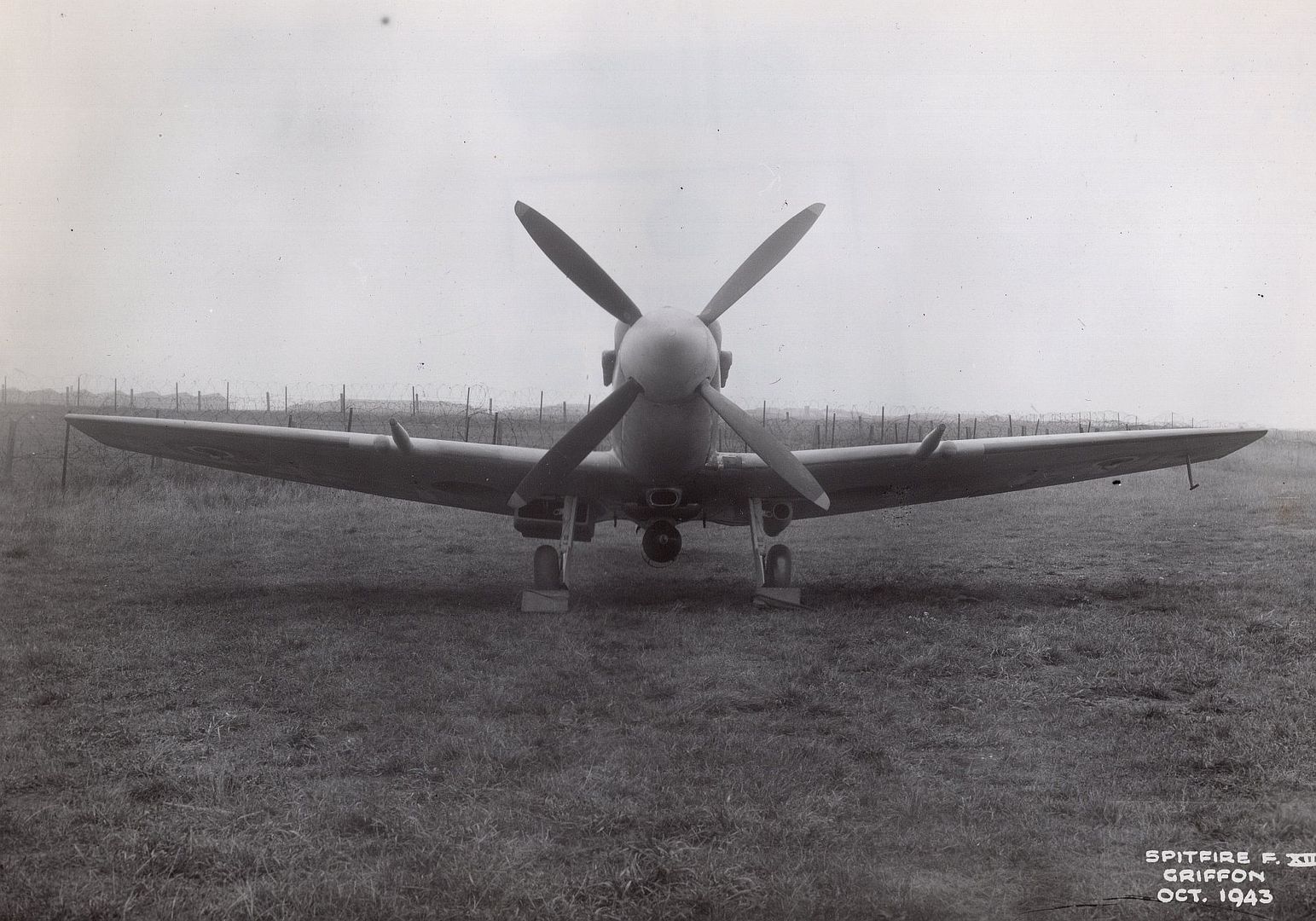
Below MB882 41 SQ In all this Spitfire Mk. XII participated in 125 sorties including 30 anti-diver patrols, completing 153 hours and 20 minutes in operations.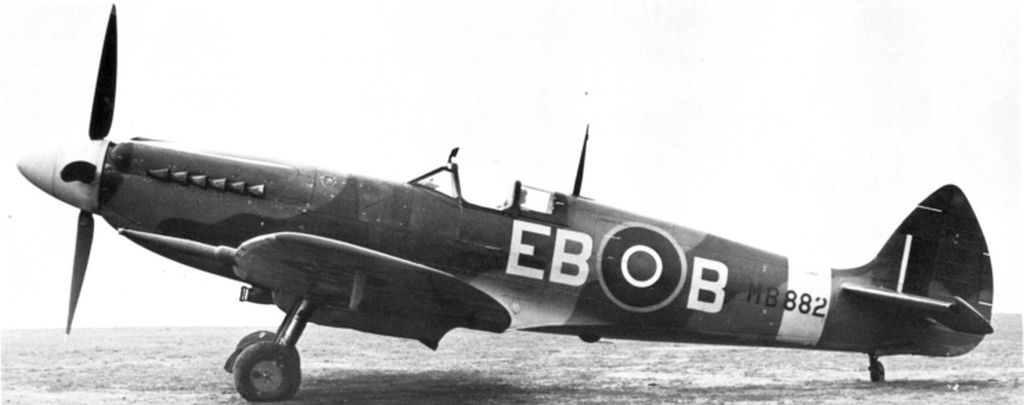
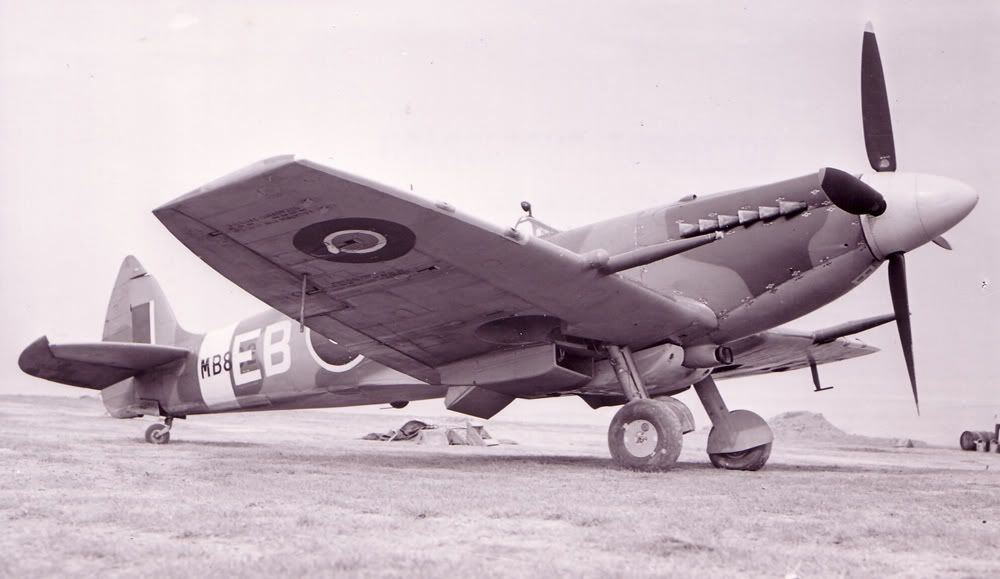
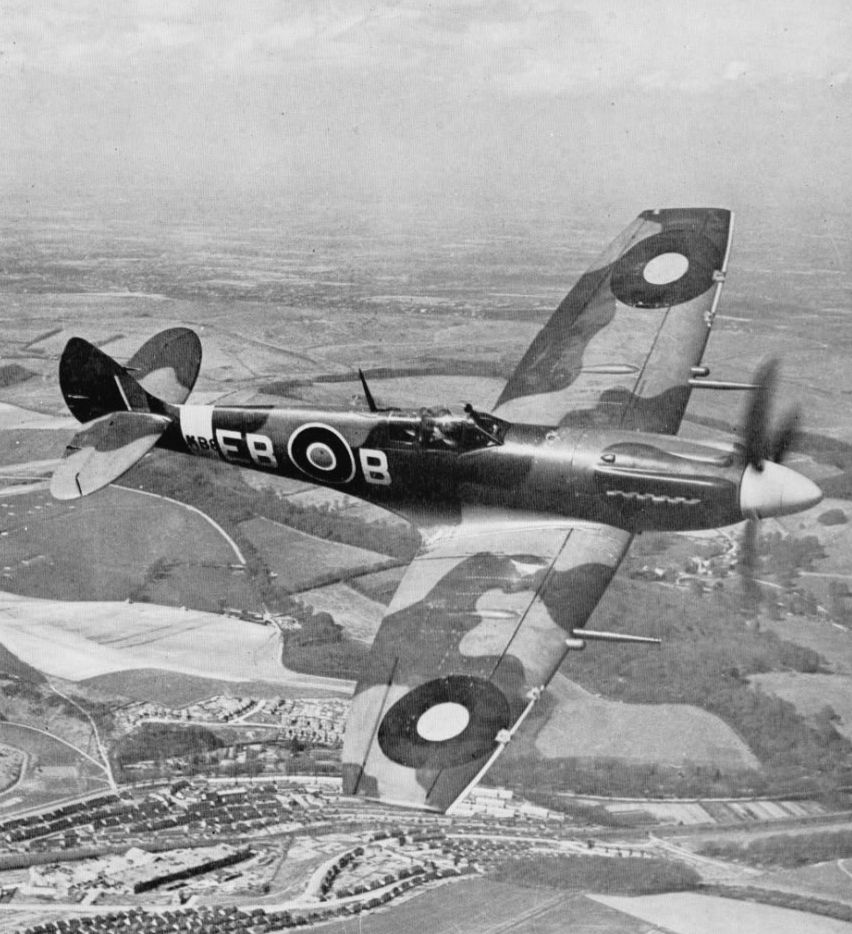

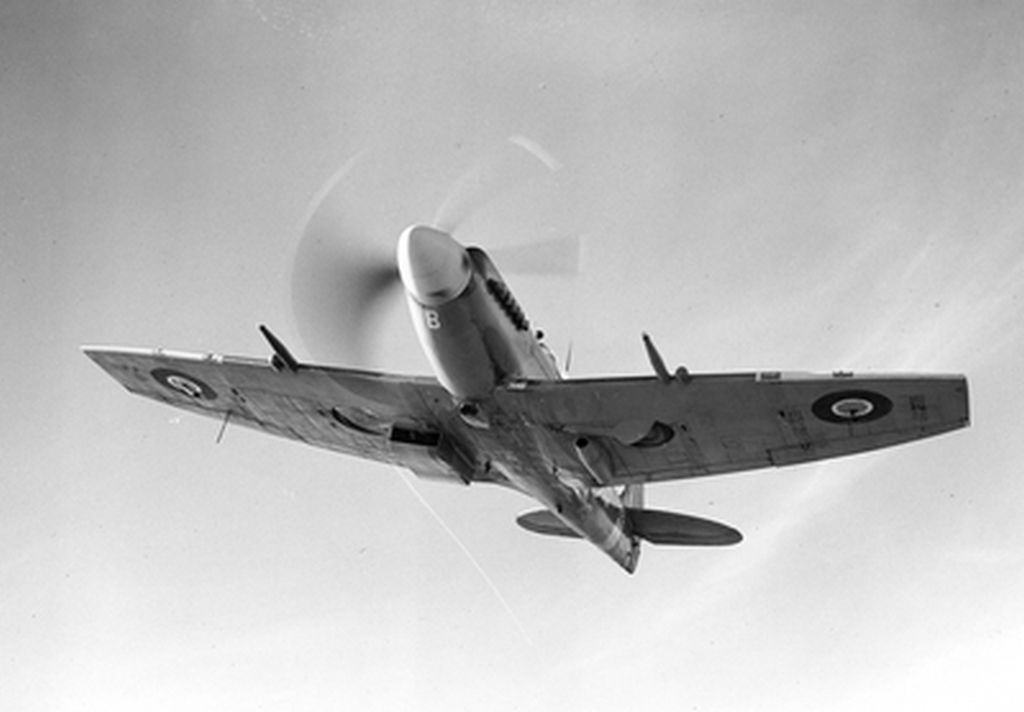
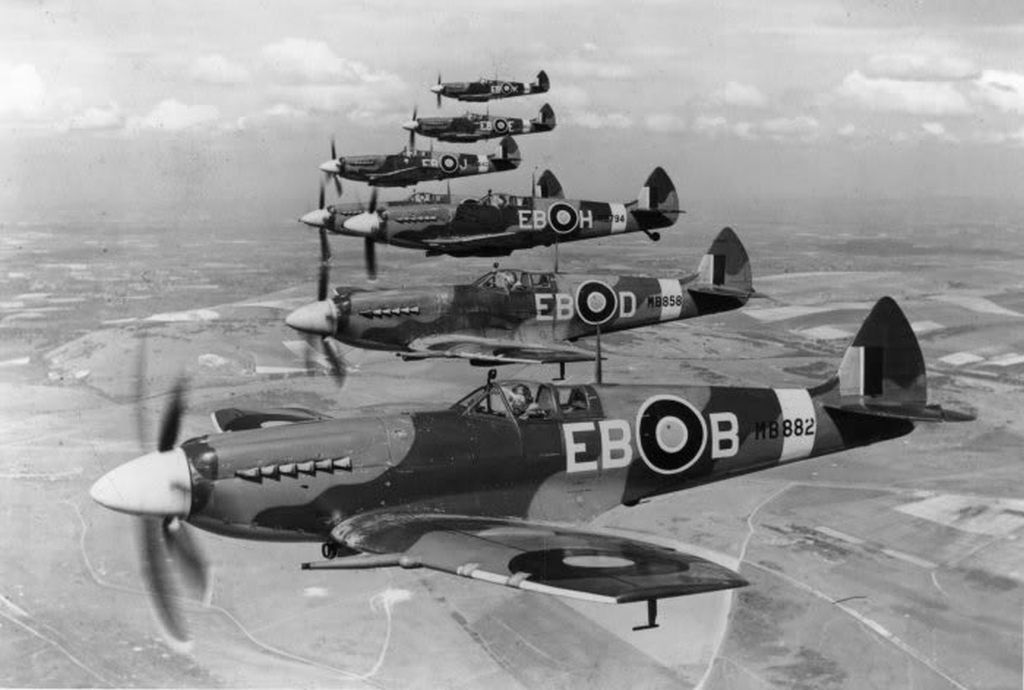
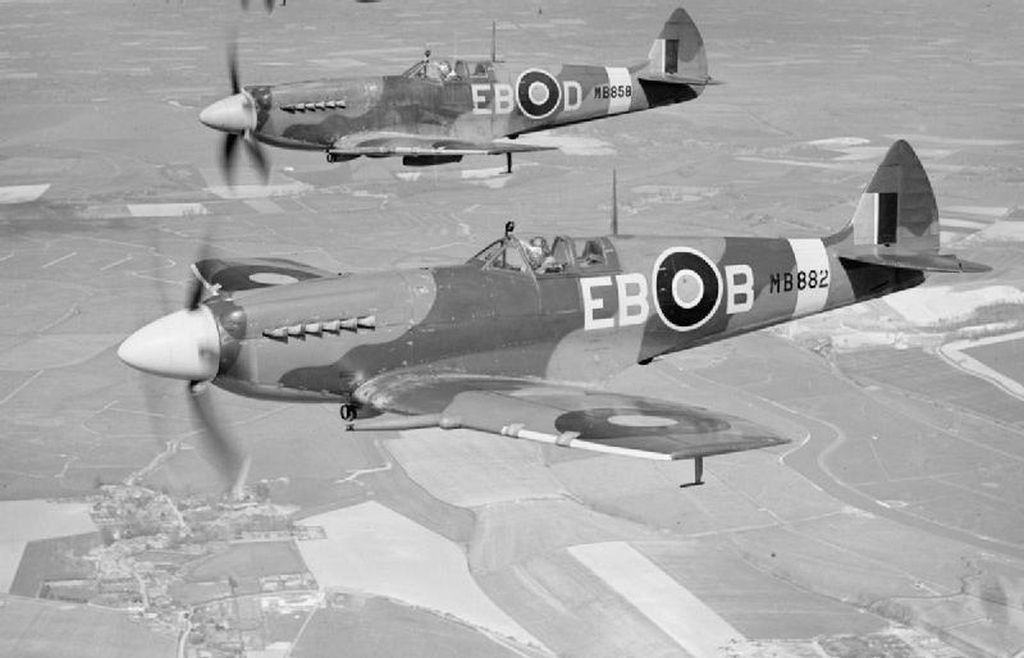

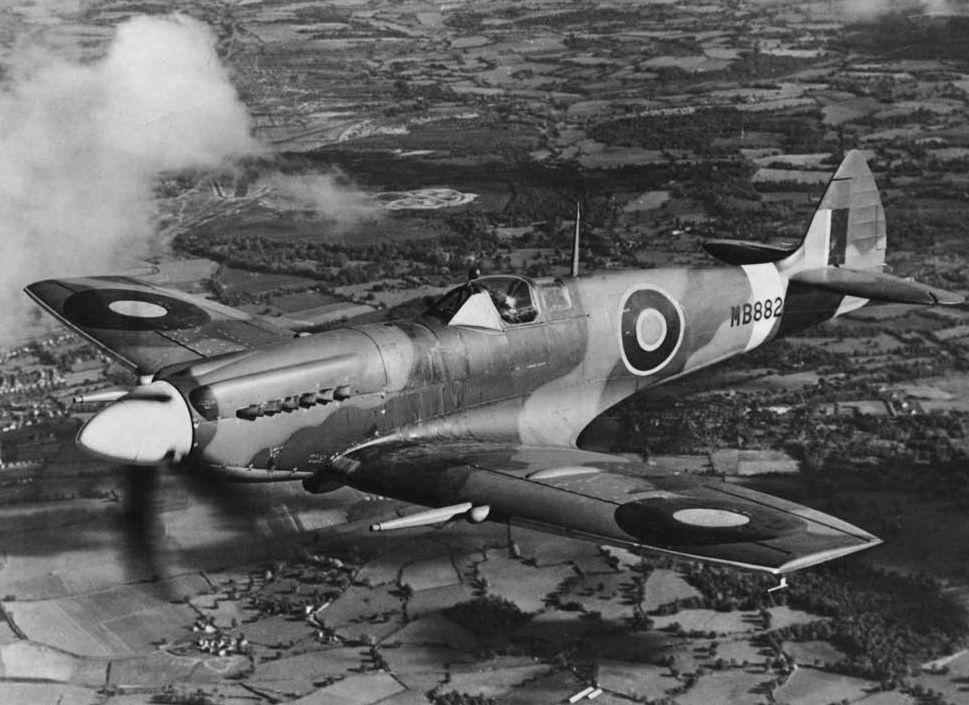
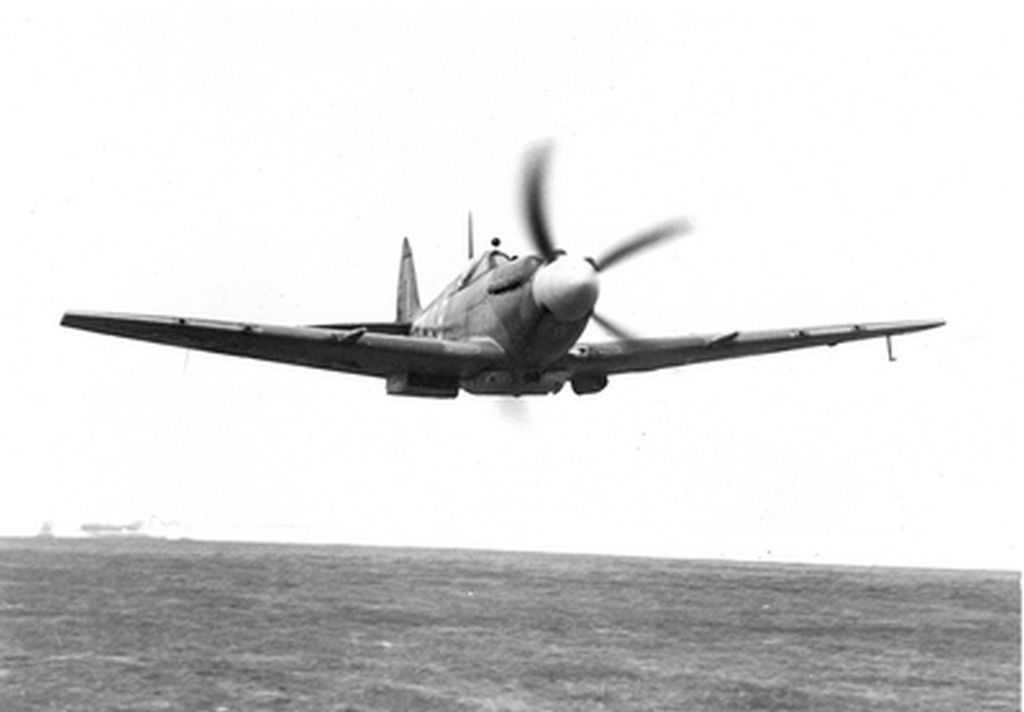
Below Spitfire Mk XII trials aircraft MB878 with 500lb bomb.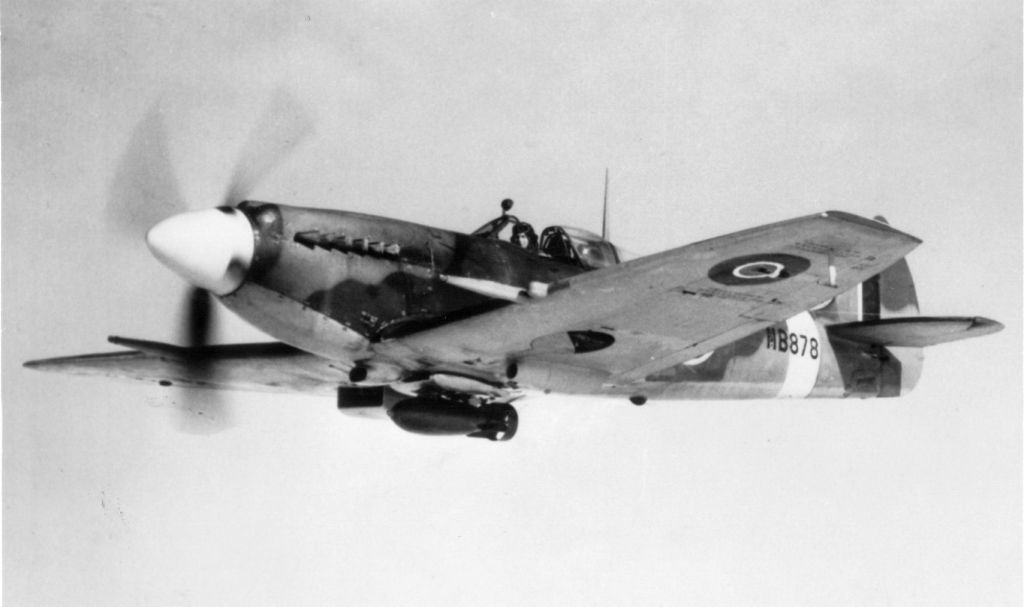
Below a fantastic belly shot of a Supermarine Spitfire Mk XII of 91. Squadron
Climb Performance
Max. rate of climb in M.S. supercharger gear 4,960 ft/min.@ 1,900 ft.
Max. rate of climb in F.S. supercharger gear 4,300 ft/min.@ 10,200 ft
Level Speed Performance
In M.S. supercharger gear 375 m.p.h. at 4,600 ft.
In F.S. supercharger gear 389 m.p.h. at 12,800 ft. -
 Level 7Thanks Duggy
Level 7Thanks Duggy -
 Level 1Happened across this forum by chance looking for Spit XII stuff. Being a long time Spit XII junkie I recognized all the images, and even a couple of my scans that made this thread
Level 1Happened across this forum by chance looking for Spit XII stuff. Being a long time Spit XII junkie I recognized all the images, and even a couple of my scans that made this thread
Wanted to correct the bottom photo. That's DP845 banking away. It was photographed by Charles Brown in October 43 while being flown by F/L R.C. Gosling. The photos from that sortie are often wrongly dated as in 42 and as the prototype Spit XII, when in fact at the time DP845 was flying with a Griffon VI engine such as went into the Seafire XV and XVII. There is another series of photos taken by Charles Brown of an unmarked MB882, one of which is posted above. It too is being flown by F/L Gosling and was taken the same day. MB882 in the 41 markings EB-B was photographed in April 44 being flown by F/L Don Smith, RAAF. He later was CO of 453 RAAF Squadron.
Image is another from the Charles Brown series showing F/L Gosling in MB882
-
 Level 1
Level 1 -
 Level 1First original Spit XII photo I was given back in 1980. MB878 used in Trial Mareth to text the viability of the XII as a dive bomber. The view over the nose was considered better than the IX. but the XII never went into the dive bombing business, although they did lose one Spit XII from 91 while testing at the squadron level when the bomb failed to come off and the wings folded up as he tried to pull out of the dive.
Level 1First original Spit XII photo I was given back in 1980. MB878 used in Trial Mareth to text the viability of the XII as a dive bomber. The view over the nose was considered better than the IX. but the XII never went into the dive bombing business, although they did lose one Spit XII from 91 while testing at the squadron level when the bomb failed to come off and the wings folded up as he tried to pull out of the dive.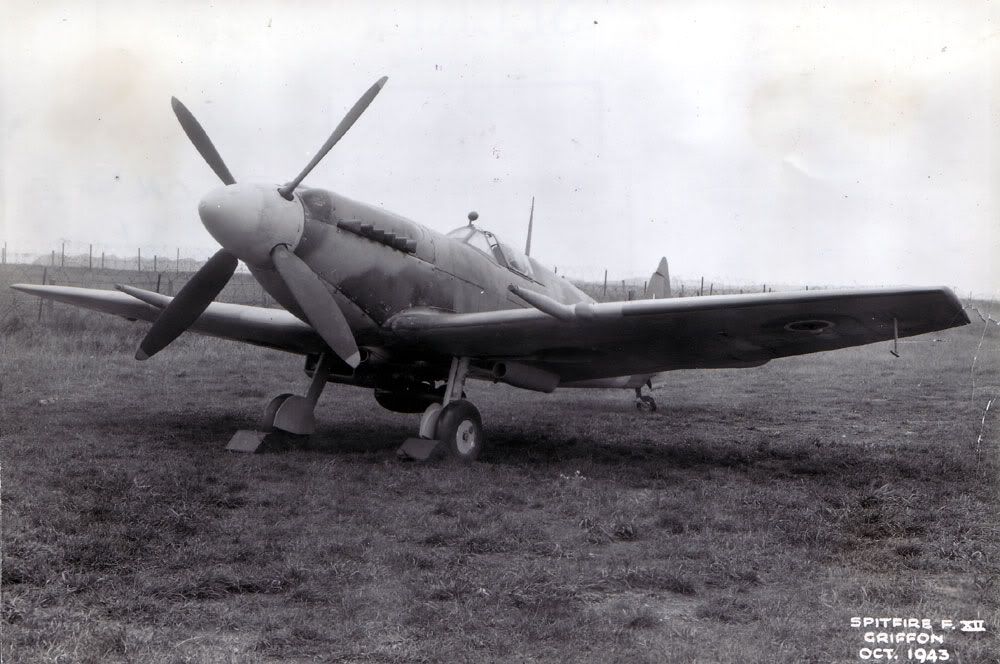
-
 Level 1
Level 1 -
 Level 1I have many more if you want to see them. One last one. This was made from a copy negative of an original photo loaned to me back in the pre-scanner days. 41 pilot Danny Reid had given it to a man named Garry Cooper in Australia. At the time Garry had the remains of Spitfire XIV RM787 that flew with 41 as EB-E. Garry loaned me the original from which the copy negative was made. This image has made it's way around the web since I first posted it and now shows up on models, profiles etc. Funny how the web goes forever
Level 1I have many more if you want to see them. One last one. This was made from a copy negative of an original photo loaned to me back in the pre-scanner days. 41 pilot Danny Reid had given it to a man named Garry Cooper in Australia. At the time Garry had the remains of Spitfire XIV RM787 that flew with 41 as EB-E. Garry loaned me the original from which the copy negative was made. This image has made it's way around the web since I first posted it and now shows up on models, profiles etc. Funny how the web goes forever
This is MB854 EB-E running up at Lympe in August 44. Not the partial and small ID stripes under the fuselage. They were operating as part of a wing with the Spit VIIs of 616 Squadron which also had those small stripes. Colin Grey was WingCo. Ironic that they had the low alt Spit and the high alt Spit flying together.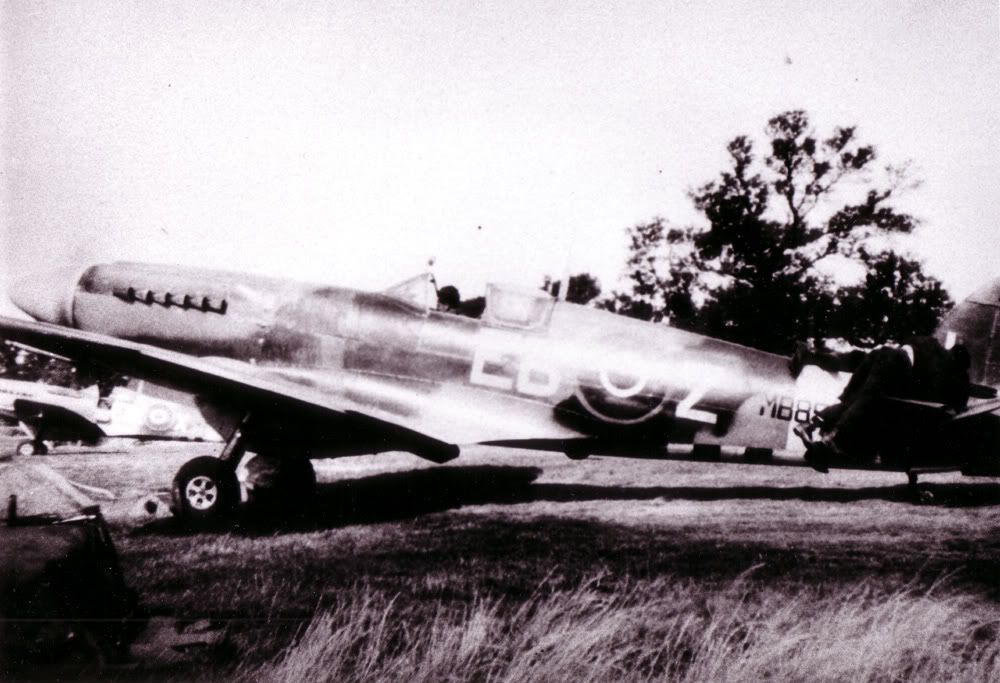
-
 Main AdminWOW what a grand entrance.
Main AdminWOW what a grand entrance.
Welcome to the hangar mate.
And of course we would be delighted to see more photo's.
Regards Duggy -
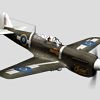 Admin
Admin
+1, welcome to A&A Guppy and thank you for the photos
Duggy
WOW what a grand entrance.
Welcome to the hangar mate.
And of course we would be delighted to see more photo's.
Regards Duggy
Post a reply
- Go to Previous topic
- Go to Next topic
- Go to Welcome
- Go to Introduce Yourself
- Go to General Discussion
- Go to Screenshots, Images and Videos
- Go to Off topic
- Go to Works in Progress
- Go to Skinning Tips / Tutorials
- Go to Skin Requests
- Go to IJAAF Library
- Go to Luftwaffe Library
- Go to RAF Library
- Go to USAAF / USN Library
- Go to Misc Library
- Go to The Ops Room
- Go to Made in Germany
- Go to Campaigns and Missions
- Go to Works in Progress
- Go to Juri's Air-Raid Shelter
- Go to Campaigns and Missions
- Go to Works in Progress
- Go to Skinpacks
- Go to External Projects Discussion
- Go to Books & Resources
